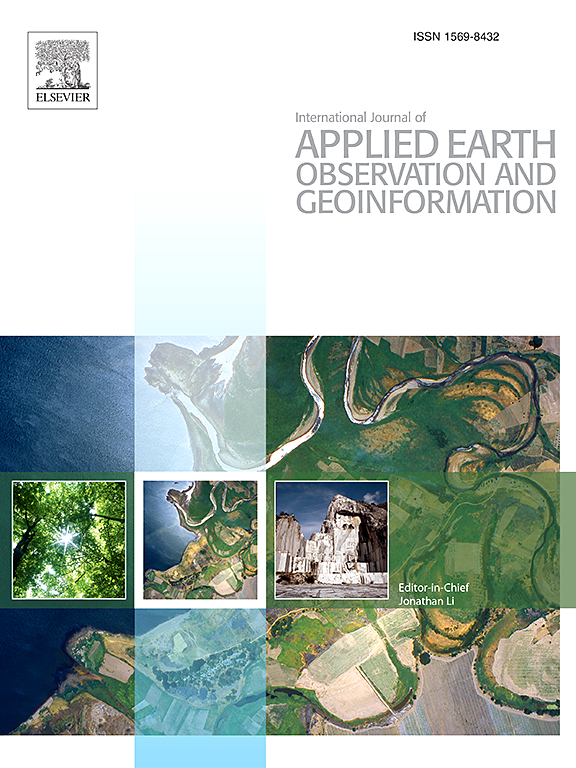Spatial-and-local-aware deep learning approach for Ground-Level NO2 estimation in England with multisource data from satellite-based observations and chemical transport models
IF 7.6
Q1 REMOTE SENSING
International journal of applied earth observation and geoinformation : ITC journal
Pub Date : 2025-03-28
DOI:10.1016/j.jag.2025.104506
引用次数: 0
Abstract
High-resolution near-surface NO2 data are crucial for monitoring air pollution dynamics. Satellite-based machine learning models are commonly used to estimate NO2 concentrations, but tailoring advanced deep learning techniques to specific environmental problems remains challenging. This study applies a two-stage deep learning approach to estimate ground-level NO2 concentrations in England at a 1 km spatial resolution from 2019 to 2021. Initially, we imputed the TROPOMI NO2 column density to a continuous 1 km resolution. We then developed an efficient spatial-and-local-aware deep learning network (SLNet) for NO2 mapping by integrating the imputed TROPOMI NO2 data with multi-source information from meteorology, chemical transport model (CTM) simulations, and other auxiliary predictors. To address the translation invariance of convolutional neural networks (CNNs), we combined a local channel to identify spatial heterogeneity in the model. Our imputed TROPOMI NO2 surfaces, which initially covered only 34.12 % of valid data, achieved full coverage with reliability and continuity at 1 km spatial resolution. Cross-validation confirmed that the SLNet model outperformed other state-of-the-art methods in estimating ground-level NO2. The prediction model achieved R2 values of 0.914, 0.919, and 0.887 for 2019, 2020, and 2021, respectively, and performed well in urban regions. Additionally, the Shapley Additive Explanations (SHAP) method revealed that features such as satellite and CTM NO2, precipitation, green space, and road density significantly contributed to estimations through both spatial and local channels. The mapping results closely aligned with ground-level observations and accurately captured spatial variations. This study advances NO2 concentration estimation by applying adaptable deep learning techniques and enhances the understanding of air pollution dynamics.
基于卫星观测和化学输运模型的多源数据的英国地面二氧化氮估算的空间和局部感知深度学习方法
高分辨率近地表NO2数据对于监测空气污染动态至关重要。基于卫星的机器学习模型通常用于估计二氧化氮浓度,但将先进的深度学习技术用于特定的环境问题仍然具有挑战性。本研究采用两阶段深度学习方法,以1公里空间分辨率估算2019年至2021年英国地面二氧化氮浓度。最初,我们将TROPOMI NO2柱密度估算为连续的1 km分辨率。然后,我们通过将输入的TROPOMI NO2数据与来自气象、化学输送模型(CTM)模拟和其他辅助预测的多源信息相结合,开发了一个高效的空间和局部感知深度学习网络(SLNet),用于NO2制图。为了解决卷积神经网络(cnn)的平移不变性,我们结合了一个局部通道来识别模型中的空间异质性。我们估算的TROPOMI NO2表面最初仅覆盖了有效数据的34.12%,在1 km空间分辨率下实现了可靠性和连续性的全覆盖。交叉验证证实,SLNet模型在估算地面二氧化氮方面优于其他最先进的方法。预测模型在2019年、2020年和2021年的R2值分别为0.914、0.919和0.887,在城市地区表现良好。此外,Shapley加性解释(SHAP)方法显示,卫星和CTM NO2、降水、绿地和道路密度等特征对空间和局部通道的估算都有显著贡献。测绘结果与地面观测结果密切一致,并准确捕获了空间变化。本研究通过应用自适应深度学习技术推进了NO2浓度估算,增强了对空气污染动态的理解。
本文章由计算机程序翻译,如有差异,请以英文原文为准。
求助全文
约1分钟内获得全文
求助全文
来源期刊

International journal of applied earth observation and geoinformation : ITC journal
Global and Planetary Change, Management, Monitoring, Policy and Law, Earth-Surface Processes, Computers in Earth Sciences
CiteScore
12.00
自引率
0.00%
发文量
0
审稿时长
77 days
期刊介绍:
The International Journal of Applied Earth Observation and Geoinformation publishes original papers that utilize earth observation data for natural resource and environmental inventory and management. These data primarily originate from remote sensing platforms, including satellites and aircraft, supplemented by surface and subsurface measurements. Addressing natural resources such as forests, agricultural land, soils, and water, as well as environmental concerns like biodiversity, land degradation, and hazards, the journal explores conceptual and data-driven approaches. It covers geoinformation themes like capturing, databasing, visualization, interpretation, data quality, and spatial uncertainty.
 求助内容:
求助内容: 应助结果提醒方式:
应助结果提醒方式:


